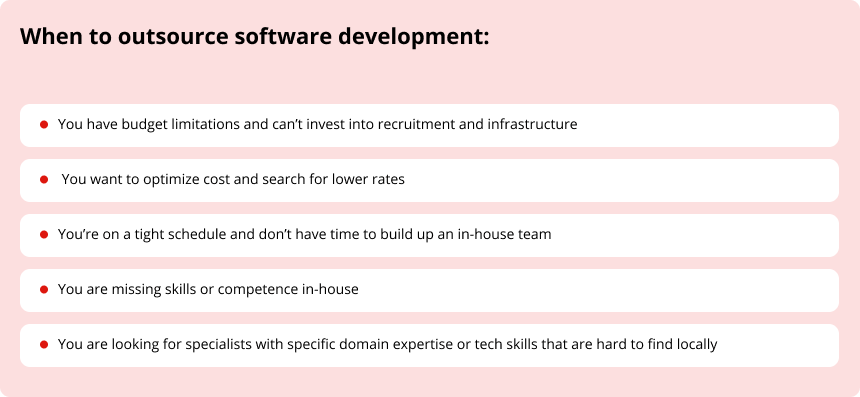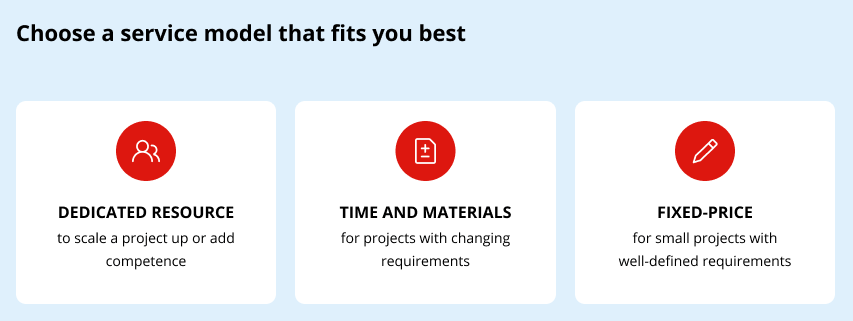Software Development Outsourcing Guide: Why, When and How to Start
Software development outsourcing is a brilliant strategy. It can help you bridge the tech talent gap, optimize costs, and speed up time-to-market. It is important, however, to know when and how to use this model to ensure it will justify your investment.
And to help you with that, we put together this guide to software development outsourcing. It is based on the market best practices and our decade-long experience in IT outsourcing and software team augmentation. Keep reading and you will find out:
- When it is reasonable to outsource (vs. hire in-house).
- Where to look for a tech vendor or individual specialists.
- How to successfully outsource software development with minimum risk and maximum gain.
- What steps to take to start with outsourcing.
But first, let’s make sure we are on the same page and there’s no mixup with alternative outsourcing models in software development such as outstaffing, offshoring/nearshoring, team augmentation, and so on.
What IS outsourcing software development model anyway? Generally speaking, if you outsource software development, you entrust the whole or part of your project development to an outside tech provider. It suits the companies that don’t have an in-house tech team and those that do but need to get more tech specialists on board.
Outsourcing is a common term for delegating work to an onshore, offshore or nearshore development team. This trio refers to location, as you might have guessed already: onshore = the same country, nearshore = nearby location, and offshore = distant location. But more about this later in the post.
What is project outsourcing then? What about outstaffing? Team augmentation?
The first one is simple. As the name suggests, it means outsourcing an entire project to a tech company that can take over the full cycle of development from ideation to launch. In contrast, we usually use the terms outstaffing, staff augmentation, or team augmentation when we add specialists to the client’s in-house team according to set requirements (skills, location, experience, etc.). For instance, if you have a dev team and could use more engineering power to pick up the pace, you can outstaff from a vendor.
For more on pros and cons of staff augmentation, along with the model’s best practices, visit our blog post.
Funny thing: before remote work became widespread, it was easy to draw a line between an in-house team that works in your office and outsourced specialists that work remotely. Now, not so much. Today, you can have an in-house team working from 7 different countries and share a coworking space with the engineers you outsource from a tech partner.
The real difference between software development in-house vs. outsourcing lies in the employment strategy. You hire in-house engineers, designers, managers, etc. and take all the expenses and responsibilities associated with recruiting, benefits, retention, and so on. Outsourced specialists are hired by your vendor. And this brings multiple benefits starting from optimized cost of development to a faster hiring process and access to a wider talent pool.
Let’s go through these and many other reasons why companies opt for outsourcing custom software development and learn how they benefit from it.

You have budget limitations
Tight budget is one of the main reasons to outsource software development. This model gives companies the flexibility they need when searching for affordable options for project development. Without compromising quality, of course. Non-tech companies that have little to no experience in software development benefit particularly from relying on outsourcing. Because when you outsource:
- You don’t have to invest in a lengthy recruitment process, employee benefits, or health insurance and take on a long-term financial commitment to employment. Your vendor does.
- You don’t need to invest in additional infrastructure, office space, and equipment. Same reason.
- You will work with an experienced tech provider who will help you find the most cost-effective solutions for your product development.
Example: A San Francisco-based producer of wireless earbuds planned to build an MVP app for their wearable. They needed a development strategy that would be cost-efficient and at the same time allow them to get a product with several unique features such as AI-based translation, in-app text and voice messaging. We suggested an optimal tech stack and integrations and developed the app with the required functionality within the budget and time limits. Read the full case study…
You want to optimize cost
Tech and non-tech companies alike use outsourcing to engage exceptional engineers from around the world. And pay less than they would have paid for hiring in-house.
- The cost of working with a remote development team from reliable outsourcing locations (e.g. Eastern Europe) is usually lower than hiring an in-house development team in the US, Australia, Canada, or Western Europe.
- Outsourcing even a part of a project provides significant savings and allows to build more, at a lower cost.
Example: One of the leading consumer analytics companies in the UK decided to scale their US-based tech team and outsource web application development to a reliable partner in Europe. Our senior full-stack, QA and DevOps engineers joined the project in 2021. This allowed the client to restructure dev teams and speed up the development by approximately 2x all the while keeping the cost under control. Read the full case study…
You’re on a tight schedule or need a temporary scale-up
Naturally, it takes less time to find a reliable tech provider with the necessary skills than to build up an entire in-house team or train new employees. This is why outsourced software product development works so well for many startups focused on fast kick-off. However, enterprise-level companies and SMBs equally value efficiency and often resort to outsourcing to speed up their projects.
- IT companies already have a core team, including lead engineers, architects, DevOps, designers and QA specialists who often can start within 2-4 weeks. Even if some competence is missing, vendors leverage their resources to quickly bring in new talent.
- Software development outsourcing is a good option to quickly ramp up an existing in-house team if you need to meet a tight project schedule.
Example: A leading UK company in the pharmaceutical sector set a goal to build an innovative data analytics and collaboration platform within 8 months. To meet this tight deadline, they had to augment their engineering department and add 15 software engineers, DevOps and QA specialists to the team. We put together a cross-functional team on short notice and helped the client meet the deadline. Our engineers in collaboration with several other tech teams continue working on the platform today. Read the full case study…
You are missing skills or competence in-house
Outsourcing development to other countries is a proven practice to access top-rated engineers that would otherwise be hard to find in your location. This model is an ideal solution for you if you experience tech talent shortage and can’t scale as fast as you would like to.
Example: A rapidly-growing travel tech startup from Spain had a hard time finding senior .NET engineers that could match high requirements for tech skills and experience. To help the company scale the backend team, we qualified one engineer at first and then expanded to 5 senior .NET engineers. The team continues working on the client’s cloud-based SaaS platform and plans to further grow in the future. Read the full case study…
You are looking for rare skills or expertise
Having access to a global talent pool, you get better chances to find specialists with the specific skills you need. This includes not only tech qualification but also domain expertise, market knowledge, or even a proven track record in a small niche.
Example: A Canadian company that specializes in printing technology needed to redesign a legacy web-to-print application and develop new functionality. Our team has a decade-long experience working with similar web applications and in-depth knowledge in this niche. We used this expertise to redesign and reengineer the system, chose a relevant tech stack, and offered a range of proven engineering solutions to develop a feature-rich high-performing frontend time and cost-effectively. Read the full case study…
Now that we figured when to outsource software development projects, let’s also learn where to go for top-tier talent.
Onshore
Onshoring approach means that you outsource to a tech company in your country of residence. This is often the case if you search for competitive rates outside big hubs (e.g. a New York company is outsourcing software development to a tech agency in Tuscon). The biggest pros of this approach are proximity, no cultural differences or language barrier, though savings are significantly lower than that of nearshoring and offshoring.
Offshore
Outsourcing to an offshore provider is one of the most economical strategies thanks to a big gap between the rates in certain locations (e.g. a UK company outsourcing to a software house in the Philippines). There are several risks connected to communication inefficiency due to time differences or a cultural mismatch, which are considered the biggest problems with outsourcing software development to offshore companies. These risks, however, can be minimized by setting up an effective communication framework from day one.
Nearshore
Nearshoring development services refer to outsourcing software product development from a vendor in a neighboring country (e.g. a German company outsourcing to Poland or the Czech Republic). This is perhaps the most balanced approach which encourages companies to choose a nearshore software development team. It combines the pros of onshoring – minimal cultural differences or language barrier, overlapping time zones – and offers viable savings like the offshore approach.
Bridge talent gap and speed up time-to-market
Get access to cross-functional tech experts on demand from a proven tech provider with over a decade-long experience in IT outsourcing.
Hire engineers
It’s not a secret that a certain percentage of outsourced software development projects fail. There are many reasons why this happens.
Some companies underestimate the problem of different timezones and find out they can’t work out an efficient communication framework with their providers. It ends up with delays, failed deliveries, and miscommunication. In other cases, IT projects fail because of the lack of transparency and feedback on both ends. It is not uncommon for clients to simply be disappointed with the quality of work. And there’s a cultural divide that can’t be ignored either.
These are all real problems and risks that, fortunately, can be avoided. And this is the part where we explain how.
Let’s talk about how to successfully outsource software development with minimum risks and maximum gain.
Set clear goals and requirements
Before you start looking into different outsourcing models and locations, lay out the basics – project goals and requirements, resources, budget, timeline and expertise you have on board. Then ask yourself:
What are your goals and expectations from a vendor? Why did you decide to outsource and what benefits of outsourcing are crucial for you? What are your major challenges and limitations?
When you answer these questions, you will have a better understanding of where to look for a tech partner. To decide on the location, consider, among other things, its legal and economic infrastructure, the country’s IT image, track record and talent pool.
Choose a service model that fits you best
There are several well-articulated service models and many ways to combine them to fit your project requirements.
Dedicated resource
This is a perfect model for a company that already has an in-house team and needs to scale it up or add competence. In this case, a dedicated team is fully integrated into the company’s team.
This model gives you high control over the development process because a great deal of or even all management is done on your end. It works for short-term projects but is most advantageous for long-term projects that require the whole team to fully focus on one goal.
Time and materials
If you want to know how to outsource software development project that yet lacks a definite scope and timeline, consider the time and materials model. It is perfect for projects with changing requirements and provides the flexibility and scalability they need.
With a T&M contract, you pay for agreed-upon milestones (new features, modifications, components, etc.). On one hand, it’s harder to keep control over the overall project cost. On the other hand, it aligns with agile development methodology and allows to optimize the cost of building a new product in the long run.
Fixed-price
Fixed-price is the least flexible but the most predictable contract. A company and vendor agree upon the scope of the project, development plan and a total fixed payment upon completion. It requires long preparation and a well-defined contract, documented specifications of the project and acceptance criteria.
It is a working strategy for small projects like Discovery or a small-scope MVP but an unsuitable model for long-term collaboration.

Review potential vendors
There are many criteria according to which you will choose your vendor. Aside from learning about the location, team composition, skills and pricing, you need to make sure that a tech provider:
- is ready to set up an effective communication framework from the very start and has processes and practices in place to provide transparency and control over budget and project development;
- has the capacity to scale up and engage more specialists if you plan to work long-term;
- has proven verifiable track record and either expertise in your domain or specialists (business analysts, project managers) who could gain relevant knowledge and share with the team;
- has strong business ethics, and your values align.
Make sure your IP and data are safe
Security is often the reason why companies hesitate to outsource software development. How can we share customer data with an outside vendor? What are their security policies? And who will own the code?
Experienced vendors must be able to answer these and many other questions regarding data security. Moreover, a reputable tech company has data protection and security practices in place. Additionally, you should be able to sign an NDA at an early stage of negotiation if you deem it necessary.
Start with a small project
This is one of the simplest tips for a company that has never done outsourcing before and is up for new product development. Starting small with a research project or a milestone is a proven strategy to check if the vendor you’ve chosen is, in fact, a good match without long-term commitment or a substantial investment. Discovery or UX/UI design projects are perfect for this purpose.
It’s nearly impossible to successfully outsource software development without building trust between all the stakeholders. And trust is not something that just appears overnight. It is a result of continuous effort and diligence.
Over these years, we have developed several principles that help us work with enterprise-level companies for 5 and even 10 years, build full-stack teams to bring new tech products to life and help our clients – companies from the US, UK, EU, Canada, Australia – achieve their goals.
- Treat the client’s business objectives and long-term goals as your own.
- Be proactive but not intrusive. We are considerate of our client’s internal processes and operations, and we build communication framework and settings that are comfortable for both sides.
- Enable transparency and efficiency throughout the entire outsourcing software development process.
- Have an open mindset and stay flexible when it comes to changes and new challenges.
- Focus on tech excellence because anything else is not acceptable.
- Be ready to ramp up and ramp down, add competence and expertise if needed.
70 tech and business experts work on Digiteum projects right now, including more than 50 middle and senior engineers. Our cross-functional teams include:
- Business analysts, UX specialists and senior UX/UI designers.
- Software engineers with diverse skill sets and tech stack, lead engineers, architects and data engineers.
- Project managers and Scrum Masters.
- QA engineers (manual and automation), QA leads.
We provide a wide spectrum of services from IT consulting, digital strategy and innovation to a full range of custom software development services.
Hire top-tier engineers faster
Extend your team or build a dedicated development team from scratch without stretching your budget and losing quality.
Hire engineersInstead of conclusion
We’ve covered many different aspects of software development outsourcing in this guide, including locations, benefits, and tips on how to successfully outsource IT development. Using this knowledge, you can already make your first steps towards finding a suitable location, collaboration model, and, eventually, a reliable IT service provider. Contact our team for a free consultation on your current tech needs.
This post was originally published on September 14, 2021 and updated on August 4, 2022.
FAQ
- Optimize the cost of development
- Meet a tight deadline
- Ramp up in-house capacity and increase time-to-market
- Avoid long-term employment commitment
- Close competence or skill gap
- Get access to otherwise unavailable top-rated tech talent
- Set up your strategic goals and gather all the information you need to define criteria for choosing an IT vendor (project requirements, budget, timeline, limitations, capacity, technologies.
- Consider collaboration models and locations that better fit your objectives.
- Review potential candidates against your pre-defined criteria and study their track record and experience.
- Check that your vendor has adequate data security and IP protection policies in place.







